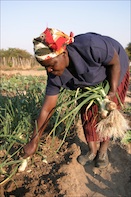Friday, April 19, 2024
News and Views from the Global South
Pension Fund Investors May be to Blame for Escalating Food Prices
Isolda Agazzi
- Long-term investors like pension funds are probably the reason why the prices of commodities, including crops, have been driven to a higher level than in 2008 when food riots erupted in 30 countries, according to the British nongovernmental organisation Christian Aid.

It is predicted that, by 2020, up to 250 million people in Africa will experience increased water stress and many will be driven to cities. Credit: Christian Aid
The social justice organisation has just released “Hungry for justice: Fighting starvation in an age of plenty”, a study indicating that between Jan. 2005 and Jun. 2008, food prices rose by an average of 83 percent. And it is even worse now: in Feb. 2011, they trumped the record figures of Jun. 2008 when food riots erupted in some 30 countries.
While financial speculation in agricultural products has largely contributed to this increase, the study suggests that the main responsibility does not lie with hedge funds and “cowboy” speculators, as usually assumed, but rather with the more prudent institutional investors such as pension funds.
“While we are not able to definitively prove that investment in commodity futures is driving up food prices, we are saying that the similarities in increases makes a strong case for urgent investigation into whether this enormous amount of money is contributing to global hunger,” Hogg specified.
In financial jargon, “futures” are what is believed a crop would be worth at some defined point in the future when it will be harvested.
While these products have been around for hundreds of years – usually as a way of giving farmers an advance income to invest in production – today companies have a huge amount of money to invest in the respective values of crops.
Another major turn has been the creation of commodity index funds, that is, indices of commodities bundled together.
Goldman Sachs opened the first commodity index fund in 1991. The bank selected 18 commodities, including wheat, coffee, cocoa and pork, and invited investors to invest in this bundle of commodities rather than in individual ones. Since then, other indices have appeared.
Following the U.S.’s deregulation of commodities trading in indices in 2000, these funds began to attract an influx of non-traditional investors, such as pension funds and managed investment funds that were betting on the rise of commodities after the burst of the dot-com bubble.
The total value held by institutional investors in these funds increased from 15 billion dollars in 2003 to 317 billion dollars in mid-2008.
In contrast with hedge funds where selling and buying of shares happen at a rapid pace and where funds move “against the market” – they buy when the price is low and sell when it is high – long-term institutional investors look for “safe” returns. And since people will always need to eat, food crops are seen as low risk investments.
“Never again should policymakers agree to such regulatory changes without assessing their impact on the poor in developing countries,” Hogg exclaimed. “It is impossible now to ban investment in commodity futures but we send a strong warning that these consequences had not been predicted. People should have thought about this more.”
The Food and Agriculture Organisation estimates that almost one billion people experience chronic hunger. “This is a scandal in an age where we should be able to feed everybody,” Hogg commented.
“There will always be shortages due to events like earthquakes, wars or cyclones, but they can be remedied with international aid. The persistent problem of hunger should attract our concern, particularly since things may get even worse in future,” added Hogg.
One of the main threats to chronic hunger comes from climate change. Some surveys suggest that if nothing is done, the number of malnourished children under five is going to be 24 million higher in 2050 than if the climate had remained unchanged.
In Africa it is predicted that, by 2020, some 75 to 250 million people in places such as northern Kenya will be exposed to increased water stress that will drive them to urban areas.
Another neglected issue is investment in agriculture. “We call for sustainable agricultural practices and more investment in agriculture,” Hogg continued.
“Agriculture has been badly hit because the West has tried to impose economic policies on developing countries that have not worked. What we suggest is that investment and research be increased. Ultimately the small-holder farmer could be the solution to the question of food security.”
In the first half of May a cabinet minister of Cameroon, speaking in Geneva, called it a “scandal” that the West African country imports 90 percent of the rice it consumes. He issued a plea to foreigners to invest in agriculture in Cameroon.
He insisted, however, that as his country aims to be self-sufficient, the resulting crops should primarily feed the local population with only the surplus being exported. Also, value addition should be done locally.
Hogg pointed out that Christian Aid does not believe that foreign direct investment (FDI) is necessarily devoid of benefits for locals.
If provisions are put in place to protect the livelihoods and land rights of people, FDI could be to their advantage. But it should be recognised that people living on the land might not have enough negotiating power to protect their livelihoods, therefore contracts have to be carefully scrutinised.

 Print
Print



